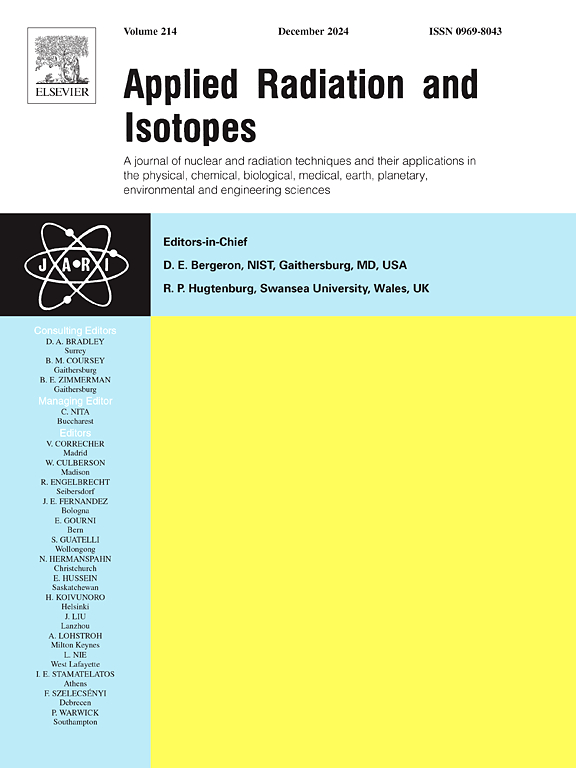Determination of neutron and gamma ray shielding properties, secondary radiation formations and neutron damage of composites containing polyester/pyrite/titanium diboride
IF 1.6
3区 工程技术
Q3 CHEMISTRY, INORGANIC & NUCLEAR
引用次数: 0
Abstract
Composite materials comprising titanium diboride (TiB2), unsaturated polyester resin, and pyrite (FeS2) at varying weight percentages were fabricated and evaluated for their interaction with neutron and gamma radiation. This study adopts a comprehensive methodology, combining theoretical calculations, experimental measurements, and Monte Carlo simulations using PHITS and MCNP6. A strong correlation was observed among experimental results, WinXCOM data, and simulation outputs, with discrepancies remaining within approximately 5 %. To assess neutron shielding performance, fast neutron removal cross sections and partial neutron transmission rates were determined for both fast and thermal neutron energies, as well as across varying sample thicknesses. Additionally, secondary radiation effects were analyzed by quantifying the number and average energy of secondary neutrons and gamma photons generated from interactions with thermal and fast neutrons. Radiation damage parameters, including Total Ionizing Dose (TID) and Displacement Per Atom (DPA), were also evaluated. Gamma-ray shielding performance was assessed through experimental measurements, theoretical models, and Monte Carlo simulations, focusing on key parameters such as mass attenuation coefficients, kerma relative to air and concrete, and buildup factors. Among the composites, the sample labeled FeSTiB-50 demonstrated superior fast neutron attenuation capability—outperforming conventional concrete and approaching the shielding efficiency of paraffin—while all composites exhibited excellent attenuation of thermal neutrons. Furthermore, the FeSTiB-50 composite generated secondary radiation with lower average energy compared to other samples. However, the gamma-ray shielding performance was found to decrease with increasing TiB2 content, indicating a trade-off between neutron and gamma shielding effectiveness.
含聚酯/黄铁矿/二硼化钛复合材料的中子和伽马射线屏蔽性能、二次辐射形成和中子损伤的测定
制备了由不同重量百分比的二硼化钛(TiB2)、不饱和聚酯树脂和黄铁矿(FeS2)组成的复合材料,并评估了它们与中子和伽马辐射的相互作用。本研究采用综合方法,结合理论计算、实验测量和蒙特卡罗模拟,使用PHITS和MCNP6。在实验结果、WinXCOM数据和模拟输出之间观察到很强的相关性,差异保持在大约5%以内。为了评估中子屏蔽性能,测定了快中子和热中子能量以及不同样品厚度下的快中子去除截面和部分中子透射率。此外,通过量化与热中子和快中子相互作用产生的次级中子和伽马光子的数量和平均能量,分析了二次辐射效应。辐射损伤参数,包括总电离剂量(TID)和每原子位移(DPA)也进行了评估。通过实验测量、理论模型和蒙特卡罗模拟来评估伽马射线屏蔽性能,重点关注质量衰减系数、相对于空气和混凝土的kerma以及累积因子等关键参数。在这些复合材料中,festb -50标记的样品表现出优异的快中子衰减能力,优于传统混凝土,接近石蜡的屏蔽效率,而所有复合材料都表现出优异的热中子衰减能力。此外,与其他样品相比,festb -50复合材料产生的二次辐射平均能量较低。然而,伽玛射线屏蔽性能随着TiB2含量的增加而下降,这表明中子和伽玛射线屏蔽效果之间存在权衡。
本文章由计算机程序翻译,如有差异,请以英文原文为准。
求助全文
约1分钟内获得全文
求助全文
来源期刊

Applied Radiation and Isotopes
工程技术-核科学技术
CiteScore
3.00
自引率
12.50%
发文量
406
审稿时长
13.5 months
期刊介绍:
Applied Radiation and Isotopes provides a high quality medium for the publication of substantial, original and scientific and technological papers on the development and peaceful application of nuclear, radiation and radionuclide techniques in chemistry, physics, biochemistry, biology, medicine, security, engineering and in the earth, planetary and environmental sciences, all including dosimetry. Nuclear techniques are defined in the broadest sense and both experimental and theoretical papers are welcome. They include the development and use of α- and β-particles, X-rays and γ-rays, neutrons and other nuclear particles and radiations from all sources, including radionuclides, synchrotron sources, cyclotrons and reactors and from the natural environment.
The journal aims to publish papers with significance to an international audience, containing substantial novelty and scientific impact. The Editors reserve the rights to reject, with or without external review, papers that do not meet these criteria.
Papers dealing with radiation processing, i.e., where radiation is used to bring about a biological, chemical or physical change in a material, should be directed to our sister journal Radiation Physics and Chemistry.
 求助内容:
求助内容: 应助结果提醒方式:
应助结果提醒方式:


